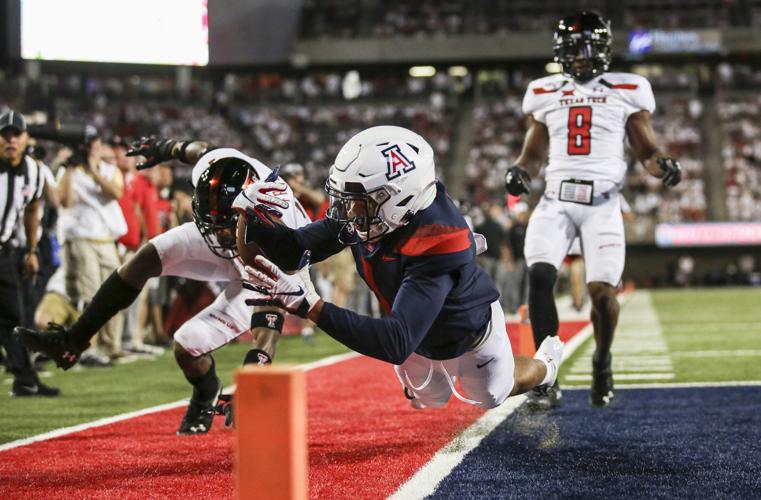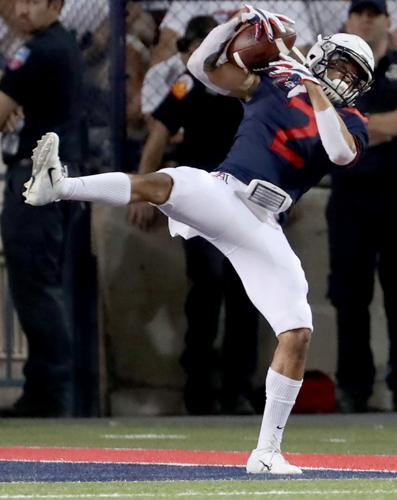For better or worse, one of the innovations at Arizona Stadium this season is the presence of a clock with illuminated red digits ticking off the time remaining during television commercials.
A man stands on the 20-yard line, holding the clock aloft during game stoppages. Far too many times in Arizona’s victory over Texas Tech, that clock began with four minutes and ticked slowly toward 0:00.
The man with the clock does not take his place on the 20-yard line during replay reviews. There’s no strict time limit on TV replays. Sometimes replay stoppages go beyond three or four minutes, but there is no visible reminder of time grinding away as referees attempt to get it right.
There should be. It should be two minutes, max. If there is no clear and overwhelming evidence to overturn a call in, say, 90 seconds, the game should continue in two minutes.
That’s part of the reason Saturday’s game was extended to 11:07 p.m.
That’s part of the reason college football games take, on average, 3½ hours to complete.
Those TV reviews are now an essential part of the fabric of college and pro football and if you’ve got a better idea, let’s hear it. Getting the call correct, even if it takes two minutes to overturn the referee’s initial decision, is a must.
But four or five minutes? That’s excessive. It kills the “fan engagement” variable so important to schools struggling to maintain ticket sales. The attention span of TV viewers is challenged.
In the final, all-decisive moments of weekend games between Arizona State-Michigan State, USC-BYU and the Denver Broncos and Chicago Bears — among dozens of others — TV replays determined the outcome.
It’s not foolproof. On Monday, the Pac-12 admitted that ASU’s victory at Michigan State was flawed by a missed call on a game-deciding field-goal attempt.
It’ll be the same thing again next weekend and every weekend for the next few months. Missed calls, blown calls and no-calls determine outcomes at the highest level, as was evident in last year’s chaotic NFC championship when a no-call on a clear pass interference play cost the New Orleans Saints a berth in the Super Bowl.
This isn’t an officials problem as much as it is a football problem. It’s not like the officials are dummies.
Do you know how educated in football you’ve got to be to officiate at the highest levels of college and pro football?
Tucson’s Rich Hall, a starting lineman on Jim Young’s 8-3, 9-2 and 9-2 Arizona teams of the mid-70s, officiated college football games for 19 years before being hired by the NFL in 2004. He has since worked more than 240 NFL games, including four playoff games. He spent eight years working the old NFL Europe summer league.
Hall, who worked Monday’s game between Cleveland and the New York Jets, sat in the officials’ booth Saturday night at Arizona Stadium. Call it continuing education on his part.
Those who officiate Power 5 college football and the NFL are the best of the best — backed up by at least two TV replay officials at every game. Among those are Tucsonans Cleo Robinson and Jim Fogltance, who officiated college football at the highest level for more than two decades before moving to the replay booth.
My question is: can officiating get any better? You sometimes watch a TV replay over and over and over, for up to five minutes, and can’t decide if a receiver caught the ball, or if a running back stepped out of bounds before getting into the end zone.
This is probably as good as it’s going to get.
The irony to Arizona fans is that the time-consuming replay system of the 21st century arrived too late.
Had today’s replay technology been in place in 45 years earlier, it’s very likely Arizona would’ve won Pac-10 championships in 1993 and 1994, played in two Rose Bowls, and won the 1975 WAC championship with a 10-1 season for the ages.
The image and historical perspective of Arizona football would’ve been forever altered.
Alas, the inevitable human error on close calls in 1975, 1993 and 1994 all went against Arizona, 0-3.
In 1975, Arizona lost the Territorial Cup to undefeated Arizona State in Tempe when a fourth-down pass to John Jefferson was ruled a touchdown. It is forever known as “The Catch,” but UA coaches and players strongly refuted the call, insisting Jefferson didn’t have control of the ball deep in the end zone.
“He never had possession at all,” said UA linebacker Orba Erby, who was involved in the play. “The ball was on the ground and they gave it to them anyway.”
Arizona couldn’t protect its 14-3 lead and lost 24-21 to finish the season 9-2. ASU went on to a 12-0 season, possibly the best in school history.
In November 1993, 8-1 Arizona went to Cal ranked No. 13 and 5-1 in the Pac-10. It had already beaten USC 38-7.
The Wildcats blew a 20-0 lead and trailed 24-20 when they got possession in the final three minutes. Quarterback Dan White completed a long pass to Terry Vaughn at the Cal 19 with a minute remaining. In an attempt to get back to the huddle in a beat-the-clock scenario, Vaughn bumped into the back judge.
The referee immediately threw a flag and penalized Arizona 15 yards on what might’ve been the most important possession in school history. A TV replay would’ve immediately shown Vaughn inadvertently bumped into the ref. But a call in 1993 was irreversible.
The game ended with an incomplete pass in the end zone.
“I was trying to get up and get to the huddle,” said Vaughn. “They said I hit the ref.”
White, sensing the damage, ran toward the referee and screamed “Oh my God! Oh my God!”
Arizona, USC and UCLA all finished 6-2; the unnecessary call against Vaughn probably cost the Wildcats a 7-1 finish and the Pac-10 championship.
A year later, a few days before Halloween at Autzen Stadium, Arizona lost to Oregon 10-9 when an official called pass interference on Arizona’s Mike Scurlock on a fourth-down pass with 3:51 remaining. It was a flag on an iffy play — no call would’ve been more appropriate — that changed UA and Oregon history.
Awarded a first down at the 16, the Ducks scored a late TD to win, triggering their first Rose Bowl season since 1958 and a rise to prominence. Arizona finished a game back of the Ducks at 6-2. The “what-if” game was again unkind to Arizona, which has struggled for most of the ensuing 25 years.
“I watched that play a dozen times,” Dick Tomey said.. “Maybe you throw a flag a few times, maybe you don’t throw it at all. It was bang-bang.”
But it was Arizona that once again got shot during an era that the TV replay had no power to right a wrong.





